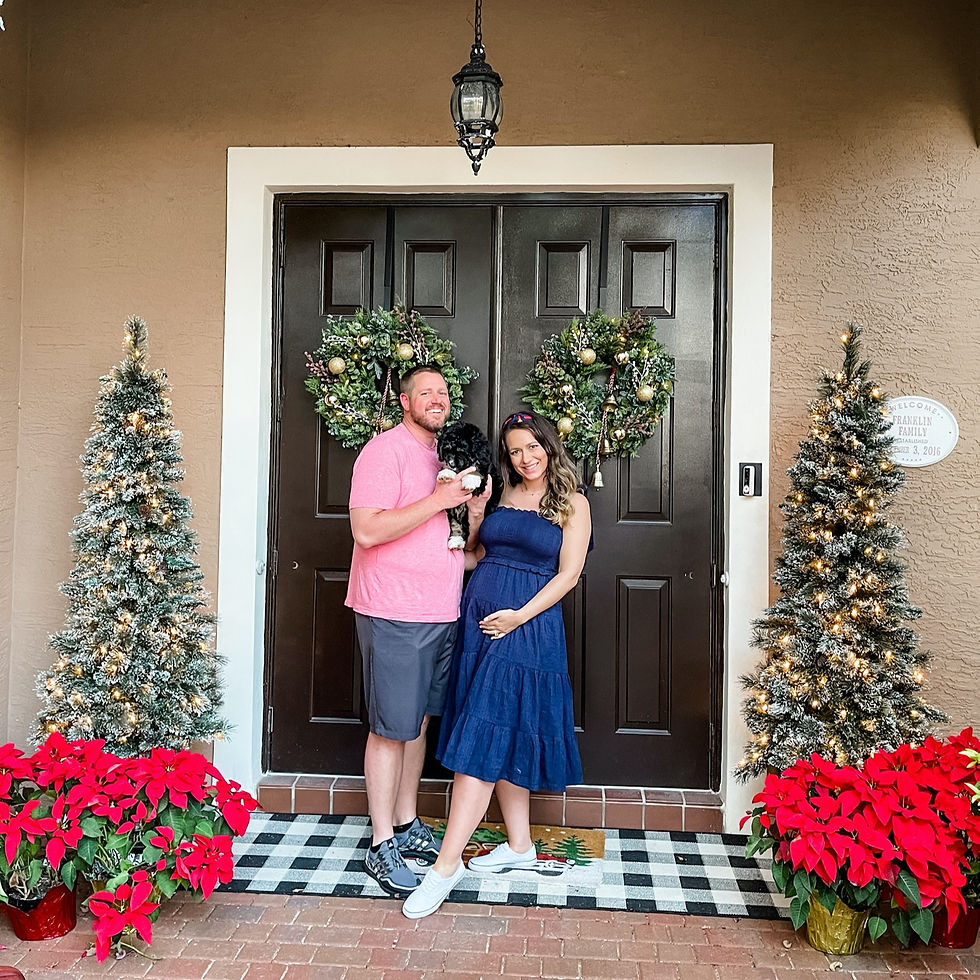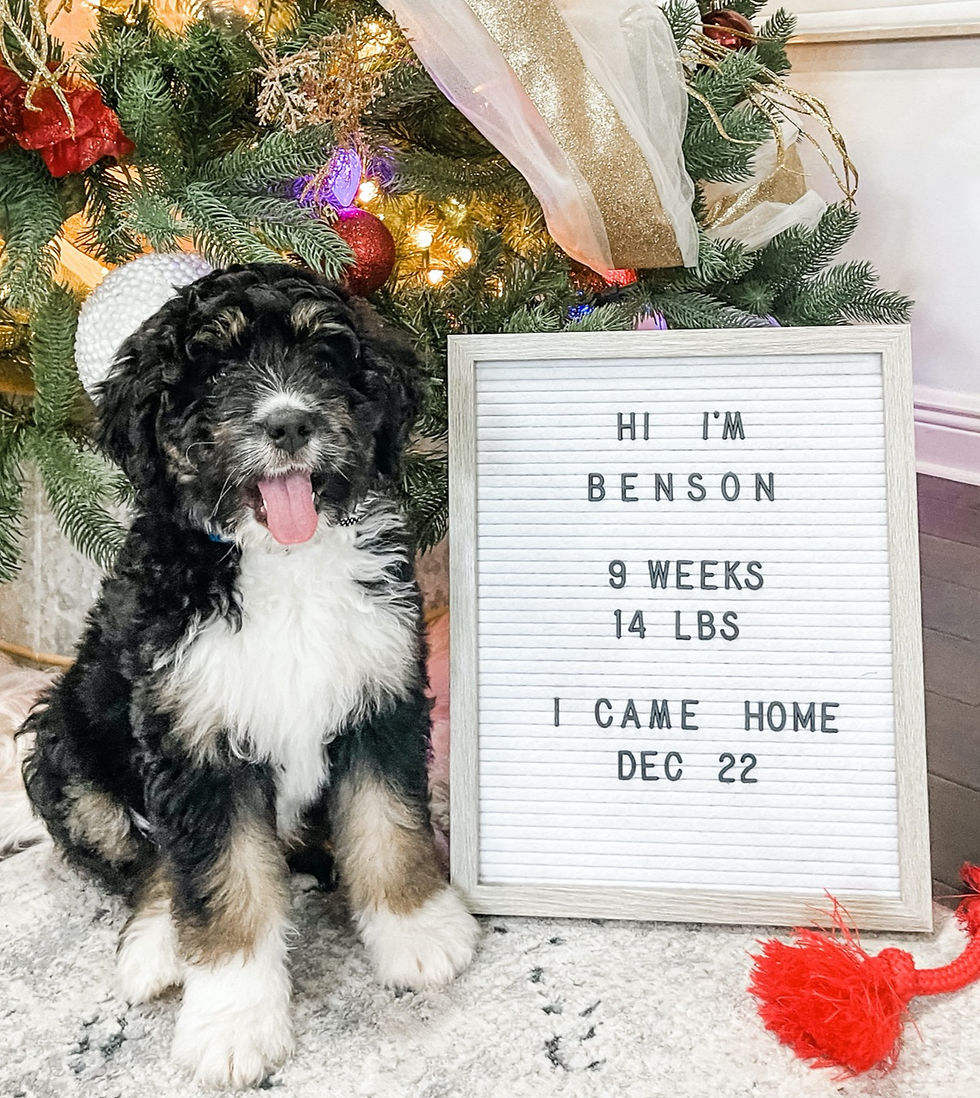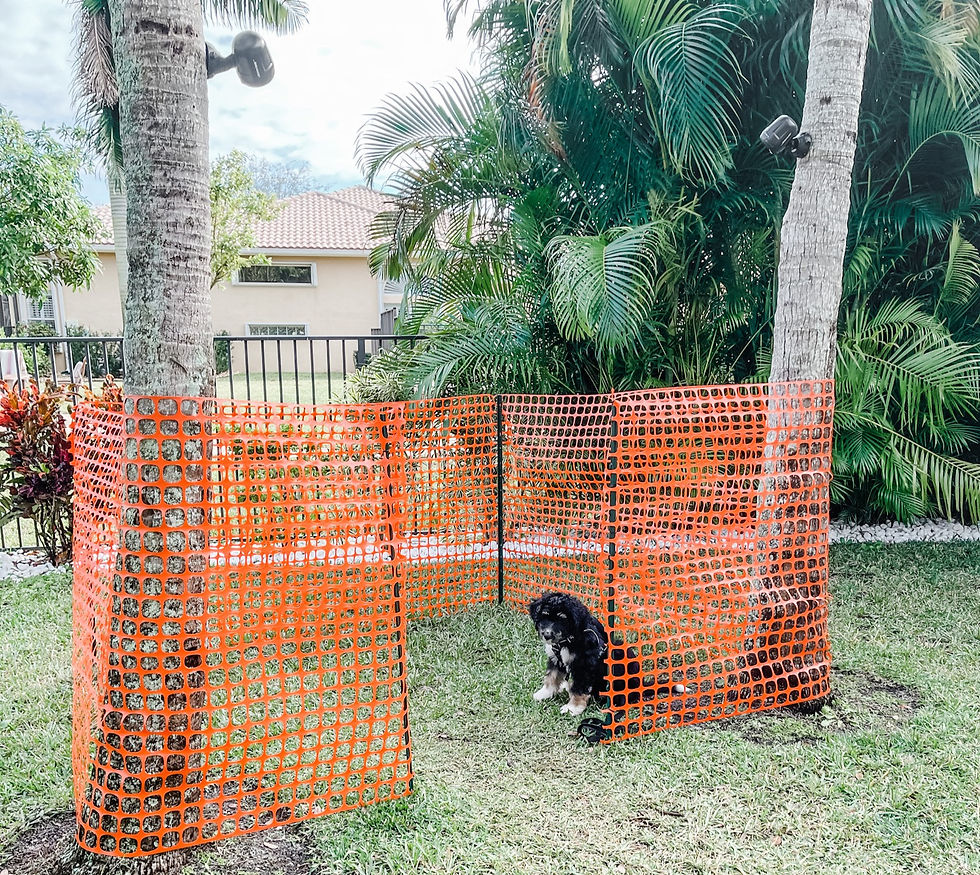Some, ok most, people may think I am crazy for getting a puppy 4 months before I am due to give birth to my first baby. Honestly, there have been glimpses of times I think I'm crazy too, but I am so excited to watch my fur baby and little boy grow up together.
I would like to introduce you to Benson Franklin! He is a F1 Standard Bernedoodle. For those of you unfamiliar with what a Bernedoodle puppy is, they are 50% Bernese Mt. Dog and 50% Poodle.

We thought a Bernedoodle would be the perfect addition to our growing family because they are hypoallergenic, which was a requirement for my husband, very smart, and medium energy.
Although, each dog have their own unique personality just like humans, out little fluff ball has been demonstrating the classic Bernedoodle personality, a lovable, lazy, goofball.
Thanks the the 50% poodle parent no only is our puppy hypoallergenic, but he does not shed. I love that I will not be constantly having to vacuum up balls of fur or lint rolling myself nonstop!
Since I only have 4 months until our little man makes his debut I am extremely motivated to get Benson trained. We are working with an amazing dog trainer to get the basics learned as soon as possible.

Tips for Crate Training Your New Puppy
The first thing we are working on is crate training. We are very lucky that our puppy took to his crate very quickly. Here are some tips on what we did to help him feel at home in his crate:
Don't use the crate as punishment: If your puppy associates his crate with being in trouble he will think every time he gets put in it is a punishment. You want his crate to feel like his safe place, where he wants to go!
Introduce it with a toy: The first night we brought Benson home we introduced him to his crate after taking him outside to go potty. We slowly did this way before his bedtime. I sat next to his crate and lead him in with a toy. He RELLY loves his Bully Sticks (we use these ones). After leading him in I placed the Bully stick in the crate and let him chew on it. I didn't close the door just yet, let him get comfortable being in it first. Do not leave your puppy unattended with their bully stick in case they chew it down to a small piece that can become a choking hazard. I found this toy to be super helpful with preventing choking and allowing them to get a better grip on their bully stick.
Do not give attention if your puppy is crying or barking: This will teach your puppy that making a fuss will get him attention and ultimately get him what he wants, out of the crate! This is probably one of the hardest steps to stick to, but also one of the most important! When your puppy is quiet or laying down nicely in their crate feed them a little training treat through the crate. Remember, the goal is to get your puppy to associate good with his crate!
Try feeding your puppy in their crate: Again, this is associating a positive experience, eating, with being in their crate. Food is one of the biggest motivators for all animals so feeding your puppy in their crate will help them learn this is a safe place where good things happen, not just where they go and their humans disappear and leave them wondering if you will ever come back.
Make them feel not alone: Most likely your puppy just came from a place where they were cuddled up with multiple brothers and sisters all day everyday, then they come to this new place and get put in this little cadge where they are all alone. That can be scary for a little puppy! As your breeder or rescue center if you can have a comfort blanket. This is a blanket that you rub on their little mates. Even if you can't smell anything on the blanket your pup sure can! This will help them feel more comfortable. You can also get this toy that had a little heart inside that you can set for 8 hours to to beat until physically turned off. It also has a little warming pouch you can add into a safe Velcro secure pouch to really make your puppy feel like they have a friend in with them. Do make note that if your dog is an aggressive chewer this may not be the best option as they can tear it open and eat the stuffing causing some health issues, but my puppy snuggles his cuddle buddy every night when it is time for bed!
Add a divider: If you find your puppy is going potty in their crate it means they have too much room! Dogs do not want to sleep where they go to the bathroom, I mean who would!? If your puppy is constantly going potty in their crate add a divider that gives them just enough room to letdown and turn around in their crate. We got this crate because it came with a diver and two doors that allow for access from the front or side. These multiple doors gave us options on how we position the crate depending on where it is in our home.
Leave the crate door open: When you puppy isn't using their crate leave the door open to allow them to explore it without being locked in. When you puppy goes into their crate praise them or give them a little training treat so they continue to associate being in their crate with something positive.
Items we found helpful while crate training
How to Potty Train Your New Puppy
Say it with me, patience is a virtue! Consistency is key! You will get this done, but there will be accidents along the way. I highly recommend a high quality enzyme spray, like this one with over 38,000 positive reviews! The reason you want to use a high quality enzyme spray while house training your puppy is because this will eliminate the enzymes in the dog's urine so they don't go back and continue to use the bathroom in that area, unlike regular carpet cleaner that just cleans up the stain.
For your first 4-7 days stick to a very strict schedule. Once you notice your puppy is catching on and not having accidents in the house you can start slowly prolonging how often you are going outside. Look for behaviors like going to the door, crying, or running away trying to create distance as signs to take your puppy out to use the bathroom. Below is a sample schedule we used to potty train our puppy:
6:30 am Wake up and immediately outside to potty
7:30 am Breakfast
7:45 am Outside to potty
8:15 am Outside to potty
9:00 am Outside to potty
10:00 am Outside to potty
11:00 am Outside to potty
12:00 pm Outside to potty
12:15 pm Lunch
12:30 pm Outside to potty
1:00 pm Outside to potty
2:00 pm Outside to potty
3:00 pm Outside to potty
4:00 pm Outside to potty
5:00 pm Outside to potty
6:00 pm Dinner
6:15 pm Outside to potty
7:00 pm Water cut off time and Outside to potty
8:00 pm Outside to potty
9:00 pm Outside to potty
10:00 pm Outside and then to bed
So as you can see, you will be spending a lot of time going outside! Fingers crossed for nice weather during your first few days of getting your puppy!
Something I recommend you do as you are training your puppy to go potty outside is to designate a 6'x6' area designated to where you bring your puppy each time. There are a couple reasons for this, first being it will make poop clean up easier later on when your dog goes outside independently. Otherwise you will be walking your entire yard everyday trying to find poop, or worse off, step in it while enjoying your yard! The second reason to have a designated area is because your puppy will learn to go potty outside faster. If you are letting them walk around your entire yard until they find the perfect place they will get distracted by all the exciting new smells. Whereas if you bring them to the same place every single time they will be like, "ok I've been here before, I know this place. This is where I go poop and pee!"
To create our designated potty area we purchased some inexpensive fencing and posts from Home Depot. We took our 6 foot leash and set it in the center and measured out the circumference going around the center of the leash. We ended up with a square instead of a circle just because it was easier to make but it works just the same. We also installed these battery operated spot lights for night time potty runs! I LOVE these lights!!! They were super easy for my husband to install and take D batteries. According to Amazon, these will run for a year with an average of 10 activation a day. We don't activate the lights this often so they should last even longer before we need to change out the batteries. I love that they have a motion sensor as well as a sensor that prevents them from turning on if a certain level of natural light is detected to save the batteries! These are so much easier than walking around with a flashlight and will help you quickly spot any little critters such as frogs or snakes that may wonder into your pup's potty area. This is Benson's potty area!

Another product that I love for Benson's potty area is this doggy septic tank! It makes disposing of poop so easy. No need to pick it up in a little baggy or have a trash container that is going to smell! This doggy septic tank has been so wonderful! All you have to do is rack up your dog's poop, open the lid with you foot, and drop it in! Warning: You will need to dig a hole thats about 4 feet deep to place the base of the disposal system in. My husband found it helpful to use a post hole digger for this process.
Then on a weekly basis you will add water and and some enzymes to break down the poop. I live in South Florida and even with our heat and sun beating down this system does not smell!!! The only time I get any hint of a poop smell is when I am right over it and open it to quickly drop in more poop. I am also 6 months pregnant and super sensitive to smells.... this has been a god send!
Items we found helpful while Potty Training
How to Introduce a New Food to Your Puppy
A lot of breeders or rescue homes / foster homes will have chosen a food that you may not want to continue, but abruptly changing your dog's food to a new one will cause a very upset stomach and a possible disaster for your floors!
If you have done your research and want to go with a different food than what your pup is used to make sure you are making this switch gradually. Here is how we adjusted Benson to his new food!
Days 1-3: 75% original food to 25% new food
Days 4-7: 50% original food to 50% new food
Days 8-10: 25: original food to 75% new food
Days 11+: 100% new food
If your pup has a very sensitive stomach you may want to spread this across 14 days instead of 10 spending more time in the 75/25 and 50/50 ratios.
It is always a good idea to keep some puréed pumpkin on hand in case your puppy experiences an upset stomach and has loose stool. Me and Benson love this one we get from Chewy. He thinks its such a treat!
You will also want a good airtight container to prevent your dog food from going stale or bugs and critters getting into it.
Most importantly, enjoy every second with your new puppy! They grow up so fast! Some days I go to get Benson out of his crate in the morning and he has clearly grown overnight! I will not miss the puppy teeth that constantly need to be chewing on something, but I will miss this awkward goof puppy phase!
Items we found helpful while Transitioning Foods
For more cute pictures of Benson and to hang out with me daily make sure you are following me on Instagram @AnnalieseFranklinBlog



Comments